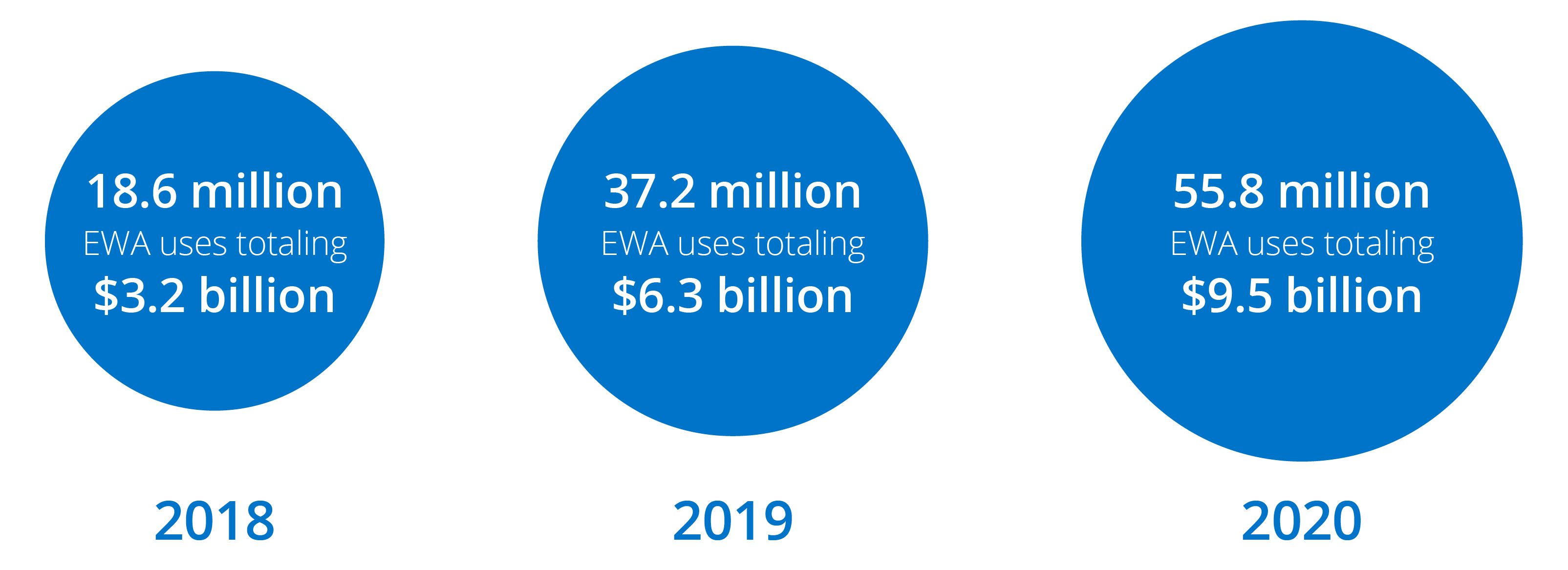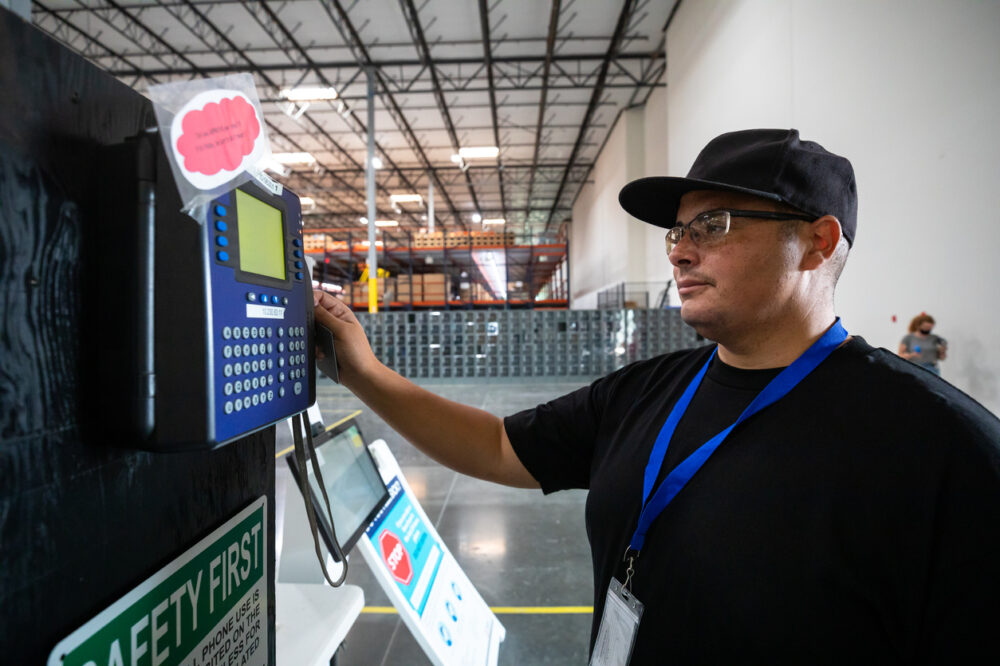Workplace Financial Health Innovation: Rolling Out an Earned Wage Access Program for Your Employees
Employers, benefits platforms, regulators, and employees are paying more attention to earned wage access (EWA) products for their potential to improve employee financial health. Employers can maximize the positive outcomes of EWA products by minimizing associated fees, explaining the program mechanics to employees, and providing a complementary suite of financial resources.
By Arjun Kaushal, Beth Brockland, Megan Skaggs
-
Program:
-
Category:

What Is Earned Wage Access?
Access to liquidity, a cornerstone of financial health, is crucial for millions of working Americans – yet, it can be both elusive and expensive.¹ As employers continue to think critically about their suite of financial benefits, many are recognizing that EWA products, paired with the appropriate suite of financial resources, have the potential to meet employees’ needs for liquidity.
EWA Product Usage, 2018-20
EWA emerged as a financial product after the 2008 financial crisis. While fintech startups were first-to-market, payroll providers, employee benefits providers, and gig platforms have since started to incorporate the service and even launch their own versions.

Source: “Employer-Based Loans and Early Pay: Disruption Reaching Scale,” Aite-Novarica Group, 2019
EWA – also known as earned wage advance or on-demand pay – allows employees to safely draw some or all of their earned wages before payday. These platforms aim to provide a meaningful alternative to high-cost credit products, such as payday loans or overdraft, and may help to lower employee stress at work.²
Employers and employees are increasingly interested in EWA. Many employers (60%) recognize that offering programs such as EWA can be a low-cost way to attract and retain employees, as well as generate goodwill among their workforces.³ Fifty-six percent of employees who had a no- or low-cost service to access their accrued wages indicated that they have used the benefit.⁴
How Do Earned Wage Access Products Work?

Funding Access to Wages
Employees’ access to wages are usually funded through the EWA vendor – typically through capital on their balance sheet or use of a debt facility. Vendors use a payroll integration (if they do not already manage payroll) or secure timesheet data to verify the earnings that can be accessed through a user-facing application.

Disbursement
Employees can receive access to their wages in one of several ways: funds are sent to an employees’ linked direct deposit account through their employer, to a bank account the employee has set up with the EWA vendor, or to a prepaid or payroll card. Most EWA companies allow users to access 50%-100% of earned wages at a given time. Rules around accesses per pay period or per month and ability to take consecutive accesses vary by provider and by employer.

Payment to EWA Vendor
Wages accessed prior to payday are typically recouped from the users’ very next paycheck, usually meaning a repayment period of less than two weeks. EWA providers have at least a 97% recoupment rate; for those who may have difficulty repaying, some offer referrals to local resources to provide support.

Timing of Payments
Accesses are sent to an employee’s external bank account via direct deposit typically the next business day. Transfers to externally linked debit or prepaid cards can take up to 48 hours. Transfers can be made instant for a $1-$5 fee, depending on the vendor. Conversely, transfers can be instant and often are free for bank accounts or cards offered by EWA vendors.⁵
Sources: Earned Wage Access and Direct-to-Consumer Advance Usage Trends, Financial Health Network, 2021.
The terms repayment and recoupment are commonly used in the industry in connection with EWA processes. Their use here is not intended to equate EWA with credit.
Are Earned Wage Access Products Good for Financial Health?
In theory, EWA products can have similar use cases as short-term liquidity products, such as small-dollar credit, helping individuals overcome problems with misaligned cash flow and providing a way to cover an emergency expense.⁵ However, despite the increasing popularity of EWA products, there is not yet enough evidence to determine their impact on employees’ financial health. Financial Health Network research has found that most EWA product users access the product consecutively over varying periods of time, and that the employee’s cost to use the product can vary based on the company’s fee model and individual usage patterns.⁶
Businesses offering EWA should ensure that their employees understand the product, and monitor the program and adjust as needed as they learn more about its impact on employees’ financial well-being. Companies should also provide a complementary suite of financial resources, such as coaching, to support employees’ overall financial health more holistically. Finally, it is important for businesses to minimize employee fees related to EWA products. Some employers choose to cover all fees for their employees, making the product free for employee use.
What Should Employers Consider When Evaluating EWA Vendors?
Employee Feedback
-
- Have you seen evidence that your employees are struggling with expenses, such as requests for pay advances or 401(k) loans?
Vendor Relationships
-
- Does one of your benefits vendors already offer this product?
- What additional financial services does the EWA vendor provide, and how do those relate to your existing benefit offerings?
- Does the vendor offer disbursement mechanisms that work for your employees, e.g., access to a bank account or prepaid card for unbanked or underbanked employees?
Costs
-
- Does offering an EWA product fit your budget? Consider the different revenue models you can use to minimize fees for your employees:
- Membership: Employees pay a certain amount each month for access to the product (which can be subsidized by employers).
- Flat fee: Vendors may charge a flat fee per use of the product, plus a fee for immediate access to the money.
- Interchange fee: Vendors that offer their own bank accounts or prepaid cards can earn revenue when employees use the debit card associated with that account.
- Per Employee Per Month (PEPM) fee: Vendors that charge this fee will also typically provide other HR services (such as payroll), positioning EWA as a feature in a broader product suite.
- Does offering an EWA product fit your budget? Consider the different revenue models you can use to minimize fees for your employees:
Regulatory Considerations
There is a lack of regulatory clarity about EWA products, specifically whether they should be regulated as credit. In late 2020, the Consumer Financial Protection Bureau (CFPB) issued an Advisory Opinions Policy relaying that it does not interpret EWA to be an extension of credit as long as it meets certain criteria, mainly limited to programs that do not charge any fees to the employee.⁷ Due to the repeated reports of confusion caused by this policy, the CFPB is examining how to provide greater clarity on these types of issues, namely how to assess whether EWA products should be treated as credit. Numerous state legislatures have also considered whether to regulate this activity. The CFPB’s influence could have an impact on these state legislative battles.⁸
For more ways to improve employee financial health, explore the Financial Health Network’s Employer FinHealth Toolkit, or get in touch with our Workplace team.

The Financial Solutions Lab (FSL) was established in 2014 to cultivate, support, and scale innovative ideas that help improve financial health. FSL focuses on solutions addressing acute and persistent financial health challenges faced by low- to moderate-income individuals, Black and Latinx communities, and other underserved consumers.
The Financial Health Network manages the Financial Solutions Lab in collaboration with founding partner JPMorgan Chase and with support from Prudential Financial.
The views and opinions expressed in the report are those of the authors and do not necessarily reflect the views and opinions of JPMorgan Chase & Co., Prudential Financial, or their affiliates.
¹ “FinHealth Spend Report 2021,” Financial Health Network, June 2021.
² “Better for Employees, Better for Business: The Case for Employers to Invest in Employee Financial Health,” Financial Health Network, May 2019.
³ “Attention payroll leaders: COVID-19 spurs surge of earned wage access programs,” KPMG, December 2020.
⁴ “Better for Employees, Better for Business: The Case for Employers to Invest in Employee Financial Health,” Financial Health Network, May 2019.
⁵ “Know Your Borrower: The Four Need Cases of Small-Dollar Credit Consumers,” Financial Health Network, December 2013.
⁶ “Earned Wage Access and Direct-to-Consumer Advance Usage Trends,” Financial Health Network, June 2021.
⁷ “Consumer Financial Protection Bureau Finalizes Advisory Opinions Policy and Announces Two New Advisory Opinions,” Consumer Financial Protection Bureau, November 2020.
⁸ “Earned-Wage Access Products Face Fresh Scrutiny from CFPB, States,” Bloomberg Law, February 2022.
Written by
Workplace Financial Health Innovation: Rolling Out an Earned Wage Access Program for Your Employees
Explore the trends. Discover new insights. Build stronger strategies.


